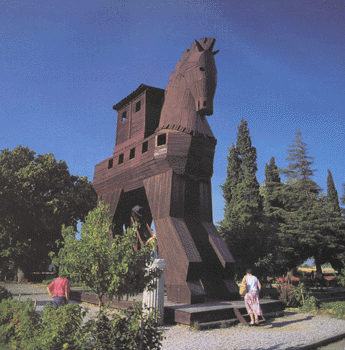CANAKKALE
The city of Canakkale lies at the narrow, 1,200 meter entrance to the Canakkale Strait (theDardanelles) that connects the Sea of Marmara and the Aegean. Passenger and car ferries run daily between Canakkale on the Asian side and Eceabat and Kilitbahir on the European side. Yachts navigating the straits stop at the well-equipped Canakkale Marina. Hotels, restaurants and cafes along the promenade offer a place to enjoy the traffic in the harbor, as well as a view of the Kilitbahir Fortress and the Canakkale Archaeological Museum.

Veterans’ Memorial, Gelibolu National Park
In 1451, Sultan Mehmet II, later the conqueror of Istanbul, built one fortress on the European side of the Canakkale Strait at Kilitbahir and one on the opposite shore at Cimenlik to control the passage of ships through the strait. Today the Cimenlik fortress serves as a military museum dedicated to the World War I Battle of Canakkale.

Canakkale Harbor
Gelibolu Peninsula Historical National Park was established to honor the 500,000 soldiers who gave their lives on Gelibolu, also known as Gallipoli. In 1915, Mustafa Kemal, commander of the Turkish army, led a successful campaign to drive out allied powers from the area. The park includes memorials, monuments, cemeteries amid the natural beauty of the Ariburnu Cliffs and Tuz Golu (Salt Lake). The beauty of the green hills, sandy beaches and blue waters provides an honorable resting place for the soldiers, who bravely fought and died in the historic battle. You cannot help but sense the heart of the Turkish nation in the patriotic spirit of the place.

Grapes
Homer immortalized Truva (Troy) in his stories of King Priam, Hector, Paris and the beautiful Helen. Archaeological excavations have revealed nine separate periods of settlement including ruins of city walls, house foundations, a temple and a theatre. A symbolic wooden Trojan horse commemorates the legendary war. The ancient harbor of Alexandria-Troas was built in the 3rd century B.C. St. Paul passed through twice, and then on his third missionary journey, he continued on to Assos. As you approach Bozcaada Island, the Venetian castle commands your attention. Then your eyes are drawn to the glistening white houses, restaurants and cafes which line the promenade. Wine seems as plentiful as water on this island, the consequence many vineyards and wine cellars. There are good, sandy beaches at Ayazma, Poyraz and Igdelik.
The largest of the Turkish islands, Gokceada is punctuated with pristine bays. Its hills, covered with the greens of pine and olive trees, are dotted with sacred springs and monasteries. Regularly scheduled ferry boats make the trip from Canakkale and Kabatepe. In August, islanders and tourists gather for colorful local fairs.

Legendary Trojan Horse, Canakkale



July 13th, 2015 at 9:19 am
[…] Balikesir and Canakkale province and sheltering many ancient sites, Kaz Dağlari has maintained its importance from the […]
October 8th, 2015 at 12:52 pm
[…] is Turkey’s largest island located in Çanakkale province. The westernmost tip called İncirburnu is at the same time the westernmost tip of […]
October 9th, 2015 at 12:13 pm
[…] in Canakkale, Troia is identified with the legend of the Trojan Horse which has its roots in one of the greatest […]